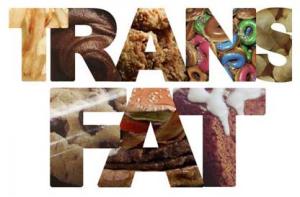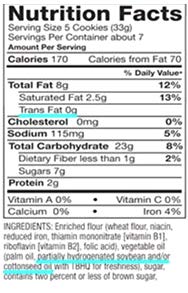The U.S. Food and Drug Administration (FDA) recently took action to significantly reduce the use of Partially Hydrogenated Oils (PHOs), the major source of artificial trans fats in our food supply.
“The FDA’s action on this major source of artificial trans fat demonstrates the agency’s commitment to the heart health of all Americans,” said FDA’s Acting Commissioner Stephen Ostroff, MD. “This action is expected to reduce coronary heart disease and prevent thousands of fatal heart attacks every year.”
The Centers for Disease Control and Prevention (CDC) estimates that reducing trans fat consumption could prevent between 10,000–20,000 heart attacks and 3,000–7,000 coronary heart disease deaths each year in the U.S.
What are trans fats?
There are two sources of trans fats, also known as trans fatty acids:
 Trans fat formed naturally – this type of trans fat is produced in the gut of some grazing animals. That’s why small quantities of trans fat can be found in animal products like meat, milk, and milk products.
Trans fat formed naturally – this type of trans fat is produced in the gut of some grazing animals. That’s why small quantities of trans fat can be found in animal products like meat, milk, and milk products.- Trans fat formed during food processing – this type of trans fat is created when hydrogen is added to vegetable oil (a process called hydrogenation) to make it more solid. Partially hydrogenated oils are used by food manufacturers to improve the texture, shelf life, and flavor stability of foods. About half of the trans fat Americans consume is formed during food processing, and partially hydrogenated oils are the main source of this type of trans fat.
Why are trans fats bad?
Scientists say there are no health benefits to trans fats, which are used in processing food and in restaurants, usually to improve texture, shelf life or flavor. Eating trans fat can raise the level of low-density lipoprotein (LDL or “bad”) cholesterol and lower the “good” cholesterol, increasing the risk of heart disease, the leading cause of death in the U.S. Trans fats are widely considered to be the worst kind for your heart, even worse than saturated fats, which can also contribute to heart disease.
Do we need fats in our diet?
Dietary fats are found in both plant and animal foods. Fat is a major source of energy for the body and aids in the absorption of vitamins A, D, E, and K. Fat is also important for proper growth, development, and maintenance of good health. As a food ingredient, fat provides flavor, consistency, and stability, and helps you feel full.
The Dietary Guidelines for Americans 2010 recommends that adults consume no more than approximately one-third of their calories from fat to reduce their risk of developing chronic diseases, such as cardiovascular disease, while providing for adequate intake of essential nutrients. Infants and toddlers up to two years of age have the highest energy needs per unit of body weight of any age group. Fats are an important source of calories and nutrients for this age group.
A little bit of history…
In the 1950s, as a young researcher, Fred Kummerow, now an emeritus professor of comparative biosciences at the University of Illinois, convinced a local hospital to let him examine the arteries of people who had died from heart disease. He discovered that the tissue contained high levels of artificial trans fat.  Later, he conducted a study showing that rats developed atherosclerosis (thickening of the artery walls) after being fed artificial trans fats. When he removed the substance from their diets, the atherosclerosis disappeared. This began an almost six-decades long campaign by Kummerow to eliminate trans fats from the U.S. food supply.
Later, he conducted a study showing that rats developed atherosclerosis (thickening of the artery walls) after being fed artificial trans fats. When he removed the substance from their diets, the atherosclerosis disappeared. This began an almost six-decades long campaign by Kummerow to eliminate trans fats from the U.S. food supply.
Despite Kummerow’s research and warnings, artificial trans fats remained a staple of processed food. Well into the 1980s, many scientists and public health advocates believed that partially hydrogenated oils were preferable to more natural saturated fats. The food industry was reluctant to remove trans fats, which were cheaper than their natural counterparts, extended shelf life and gave foods a desirable taste and texture.
Frustrated by lack of action, Kummerow filed a citizen petition with the FDA in 2009, citing the mounting body of evidence against trans fat. By this time, more studies had shown that trans fats were a key culprit in the rising rates of heart disease. The advocacy group Center for Science in the Public Interest petitioned the FDA in 1994 to require that trans fats be listed on nutrition labels – a move that was put into place in 2006. In 2002, the Institute of Medicine found there was no safe level of trans fatty acids and recommended that people eat as little of it as possible. As the dangers of trans fat became clearer, public opinion shifted and food companies increasingly removed the substance from products, although it remained in a broad range of foods from cake frostings to baked goods.
In 2002, the Institute of Medicine found there was no safe level of trans fatty acids and recommended that people eat as little of it as possible.
After hearing nothing for four years after filing his petition, Kummerow sued the FDA and the Department of Health and Human Services in 2013 to try to ban PHOs unless a complete administrative review found new evidence for their safety. Three months later, the FDA announced its plan to effectively eliminate trans fats by stating that the substance no longer would be assumed safe for use in human foods.
Now 100 years old and still conducting research, Kummerow doesn’t consider his job done. He’s pushing for research to investigate the possible health hazards of oxidized fats, which are created by frying and re-frying oils as occurs in fast food restaurants.
What’s next?
Food manufacturers will have three years to remove PHOs from products. This will allow companies to either reformulate products without PHOs and/or petition the FDA to permit specific uses of PHOs. Following the compliance period, no PHOs can be added to human food unless they are approved by the FDA. Many companies have already been working to remove PHOs from processed foods, and the FDA anticipates that many may eliminate them ahead of the three-year compliance date. The FDA has not targeted small amount of trans fats that occur naturally in some meat and dairy products because they would be too difficult to remove and aren’t considered a major public health threat on their own.
Popular foods that may contain trans fats include pie crusts, biscuits, microwave popcorn, coffee creamers, frozen pizza, refrigerated dough, vegetable shortening, and stick margarines.
What should you do to maintain a healthy diet?
The Dietary Guidelines for Americans 2010 and the Institute of Medicine recommend that individuals keep trans fatty acid consumption as low as possible. There are steps that consumers can take to reduce artificial trans fats in their diets:
- Read the Nutrition Facts label and ingredient list to compare foods.

- Choose products with 0 grams trans fat.
- Check the ingredient list to see if the product contains any partially hydrogenated oil – products containing less than 0.5 grams of trans fat per serving can still be labeled as having 0 grams trans fat.
- When choosing foods low in trans fat, make sure they are also low in saturated fat and cholesterol – look for foods with 5% of the Daily Value or less. Foods with 20% or more of the Daily Value of these two components are high.
- Use monosaturated fat (canola and olive oil) and polyunsaturated fat (soybean, corn, and sunflower oil) in recipes that call for fat.
- Balance your diet with fruits, vegetables, whole grains, lean sources of protein, and low-fat or fat-free dairy products.
 For more tips on heart health, learn about the Million Hearts® initiative. Million Hearts® offers tools to assess your risk for heart attack or stroke, and provides low-fat, low-sodium, heart-healthy recipes and easy meal plans.
For more tips on heart health, learn about the Million Hearts® initiative. Million Hearts® offers tools to assess your risk for heart attack or stroke, and provides low-fat, low-sodium, heart-healthy recipes and easy meal plans.
